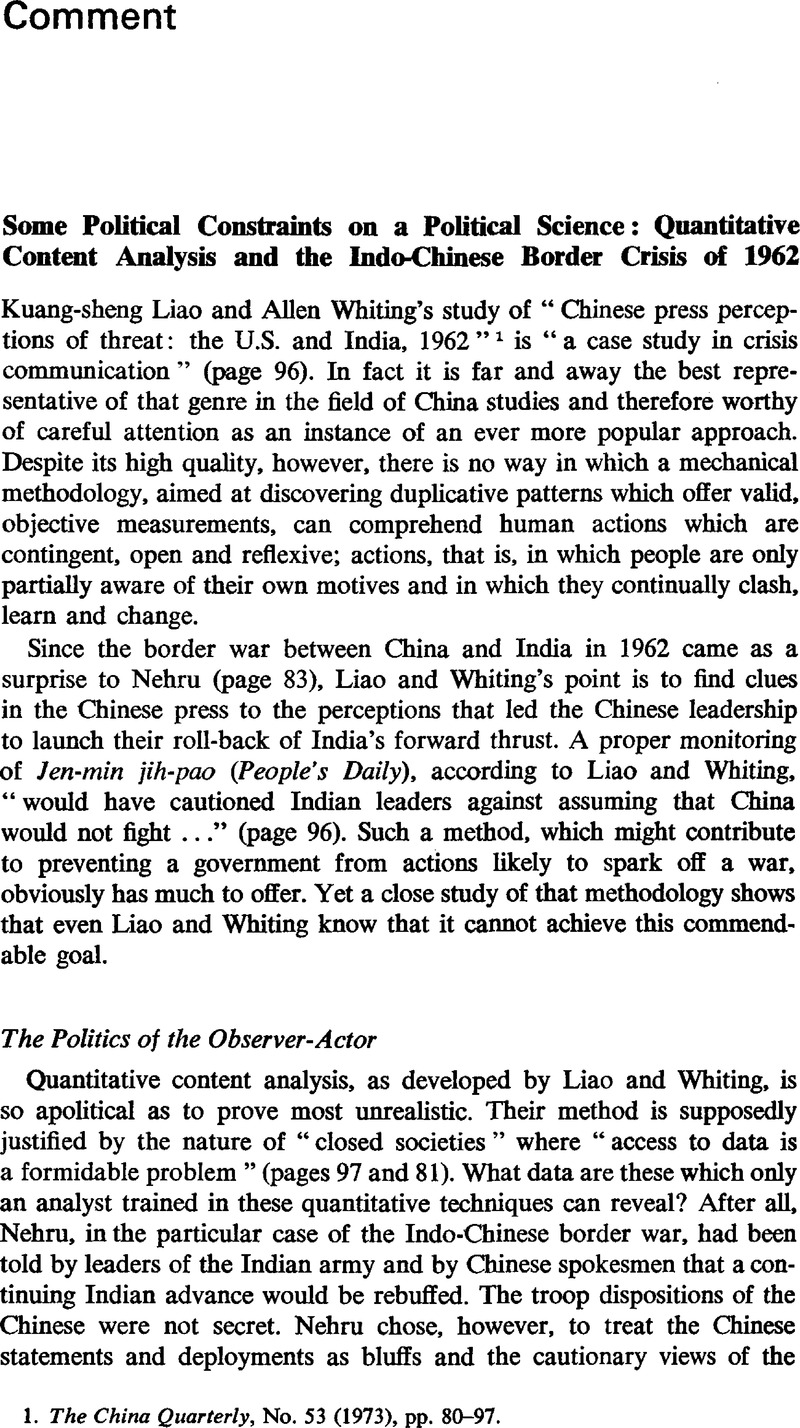Article contents
Some Political Constraints on a Political Science: Quantitative Content Analysis and the Indo-Chinese Border Crisis of 1962
Published online by Cambridge University Press: 17 February 2009
Abstract

- Type
- Comment
- Information
- Copyright
- Copyright © The China Quarterly 1975
References
1. The China Quarterly, No. 53 (1973), pp. 80–97.Google Scholar
2. Rice, Edward, Mao's Way (Berkeley: University of California Press, 1972), pp. 212–13.Google Scholar
3. Solomon, Richard, Mao's Revolution and the Chinese Political Culture (Berkeley: University of California Press, 1971), p. 444.Google Scholar
4. The former president of the U.S.A., Harry Truman, who blamed Eisenhower's reliance on staff for his inability to move swiftly and early, to do things such as woo and win Castro, persuaded Merle Miller that while “Mr Truman was often [profane],… ‘staff report’ were the two dirtiest words he uttered in all our talks together” (Plain Speaking (N.Y.: Berkeley, 1973). p. 374).Google Scholar
5. In Chen, King C. (ed.), The Foreign Policy of Communist China (Roseland, N.J.: East-West Who., 1972), p. 474.Google Scholar
6. Wilcox, Wayne, “China's strategic alternatives in South Asia,” in Tsou, Tang (ed.), China in Crisis (Chicago: University of Chicago Press, 1968), Vol. II, p. 415.Google Scholar
7. Liao and Whiting write as if all moments were alike. But any politically active person knows that events such as the CC 10th Plenum or India's 1962 elections add special weight to what acts mean before or after the event. Nehru, for example, told K. P. S. Menon, who wanted to go to China as ambassador to mediate the difficulties between the countries, that domestic political pressures precluded generous gestures before the election. See Menon, K. P. S., China: Past and Present (Bombay: Asia Publishing House, 1968, p. 54)Google Scholar. The point is that whatever the truth value of Nehru's rationalization events have different political weights depending on when they occur, and Liao and Whiting's methodology cannot capture this.
8. Schurmann, Franz, The Logic of World Power (N.Y.: Random House, 1974)Google Scholar, follows the Chinese in ably using this approach. Unfortunately, Liao and Whiting so downgrade this matter that they have one category for all Asia and do not distinguish among the crisis areas of Taiwan, Laos and Tibet.
9. Yet Liao and Whiting begin by holding up to the reader these flawed examples of crisis studies. They first mention the study of crises in the Taiwan Straits by McClelland, Charles's team (p. 80)Google Scholar. But Whiting well knows that that work's limited data is wholly inadequate (cf. Whiting, , “The scholar and the policy-maker,” World Politics, Vol. 24 (Spring 1972), p. 234)CrossRefGoogle Scholar for any of the claims McClelland makes. Why not take the time to show precisely how the Liao and Whiting methodology is a vast improvement? Let us critically engage our energies in pointing out these flaws and advances and confront the virtually endless errors which make McClelland's study the furthest thing from science.
And why follow McClelland, as Liao and Whiting do, with a positive mention of Paul Smoker's study of Sino-Indian crisis communications? Since Smoker's conclusion, that the communication process did not permit open options, is out of line, if not actually in conflict, with Liao and Whiting's conclusions of how open the possibilities were virtually till the end, surely the reader should be told where Smoker's methodology went wrong. I believe the truth lies closer to Liao and Whiting, and I and others should be permitted to learn how to avoid other methodologies which lead to error. Instead of exposing error and advancing knowledge as part of a common search for truth, Liao and Whiting come too close to offering the equivalent of an advertising press release on the allegedly proven virtues of their product, embracing all quantitative analyses of crisis. Wisely, they leave this acclaim at the level of the vaguest imprecision.
10. Jervis, Robert, The Logic of Images in International Relations (Princeton: Princeton University Press, 1970), pp. 274–75.Google Scholar
- 4
- Cited by




